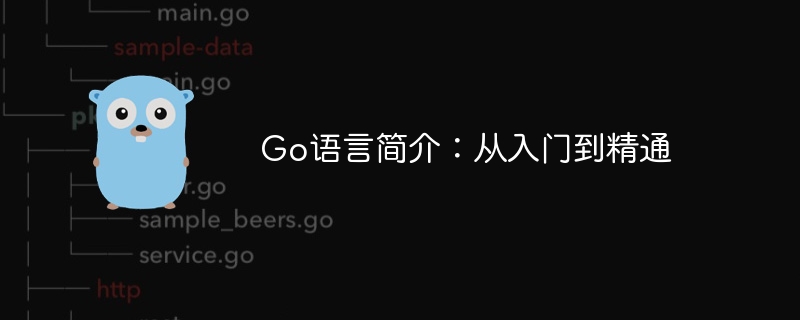

Introduction to Go language: from entry to proficiency, specific code examples are required
Introduction:
In today's dynamically developing Internet era, the diversity of programming languages has given Developers bring more choices. Go language, as an open source programming language developed by Google, is favored by more and more developers for its simplicity, efficiency, and powerful features. This article will introduce the basic concepts of Go language, explore its core features, and provide specific code examples to help readers from getting started to becoming proficient in Go language.
1. Features of Go language
2. Basic concepts of Go language
Code example:
var num1 int // 声明一个整型变量 num1 = 10 // 赋值操作 num2 := 20 // 使用:=进行声明和赋值的简化写法 str := "Hello Go" // 声明一个字符串变量
Code example:
if num1 > num2 {
fmt.Println("num1大于num2")
} else if num1 == num2 {
fmt.Println("num1等于num2")
} else {
fmt.Println("num1小于num2")
}
for i := 0; i < 5; i++ {
fmt.Println(i)
}
switch day {
case "Monday":
fmt.Println("星期一")
case "Tuesday":
fmt.Println("星期二")
default:
fmt.Println("其他日子")
}Code example:
func add(a, b int) int {
return a + b
}
result := add(1, 2) // 调用函数,并将结果赋值给result
fmt.Println(result)Code examples:
func sayHello() {
fmt.Println("Hello, goroutine!")
}
go sayHello() // 启动一个goroutine
time.Sleep(1 * time.Second) // 如果主函数不等待goroutine执行完毕,程序会立即退出
// 使用channel进行通信
ch := make(chan int) // 创建一个整型channel
go func() {
ch <- 10 // 发送数据到channel
}()
num := <-ch // 从channel接收数据
fmt.Println(num)Summary:
This article briefly introduces the characteristics and basic concepts of the Go language, and uses specific code examples to help readers understand. The Go language's simplicity, ease of use, concurrency support, and fast compilation make it outstanding in the field of Internet development. I hope that by studying this article, readers can better understand and use the Go language, from entry to proficiency.
The above is the detailed content of Go language from entry to mastery: an introduction. For more information, please follow other related articles on the PHP Chinese website!
 Usage of Type keyword in Go
Usage of Type keyword in Go
 How to implement linked list in go
How to implement linked list in go
 What are the Go language programming software?
What are the Go language programming software?
 How to learn go language from 0 basics
How to learn go language from 0 basics
 What are the methods to implement operator overloading in Go language?
What are the methods to implement operator overloading in Go language?
 What are the operators in Go language?
What are the operators in Go language?
 The difference between i5 and i7
The difference between i5 and i7
 How to check ports in Linux
How to check ports in Linux
 0x00000006 What to do if the printer cannot be connected?
0x00000006 What to do if the printer cannot be connected?